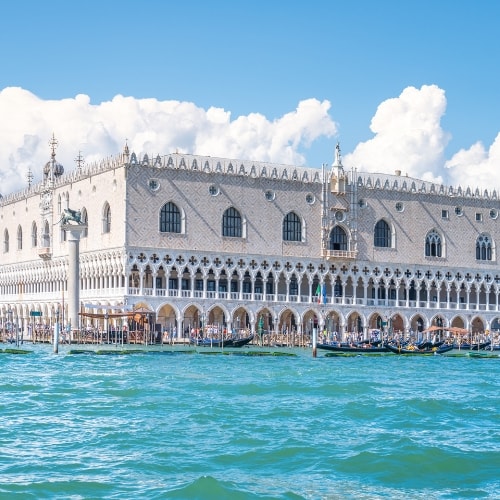

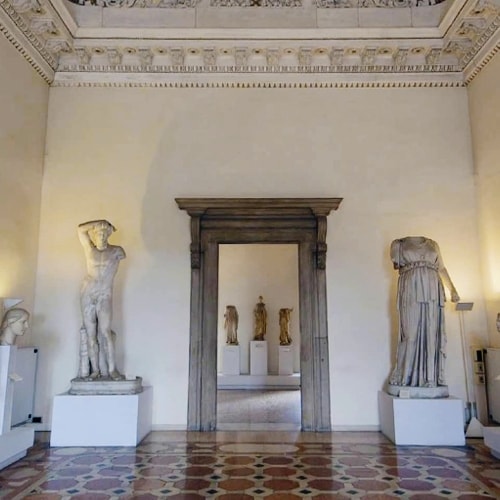
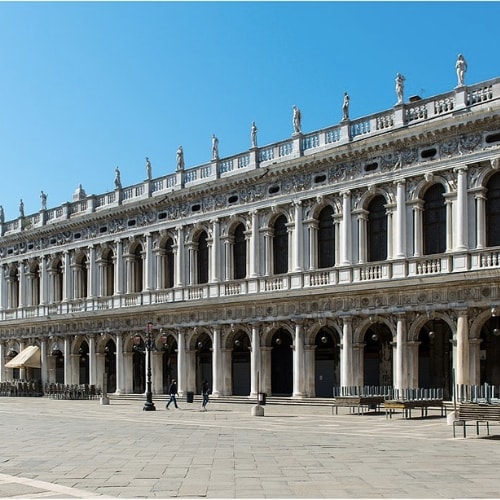
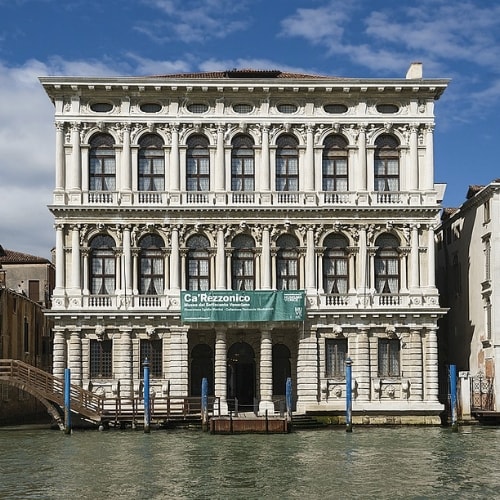
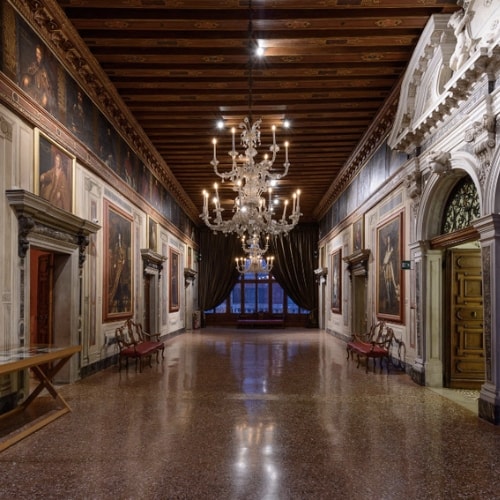

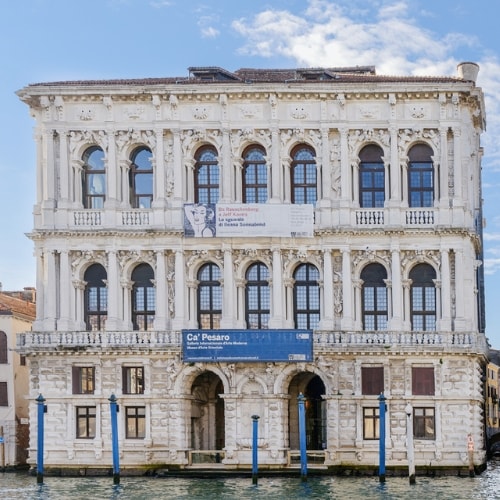

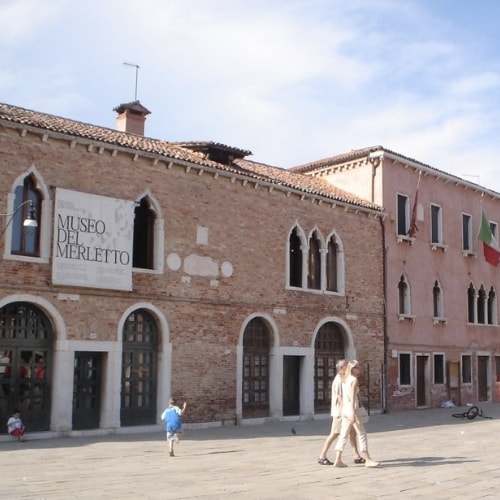
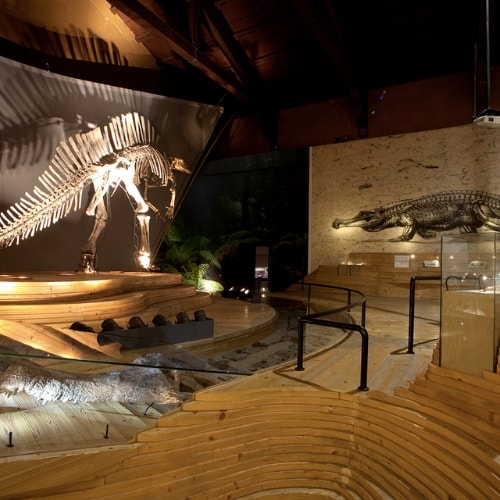
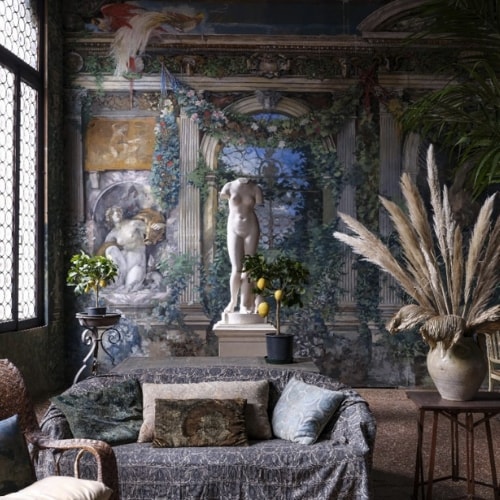
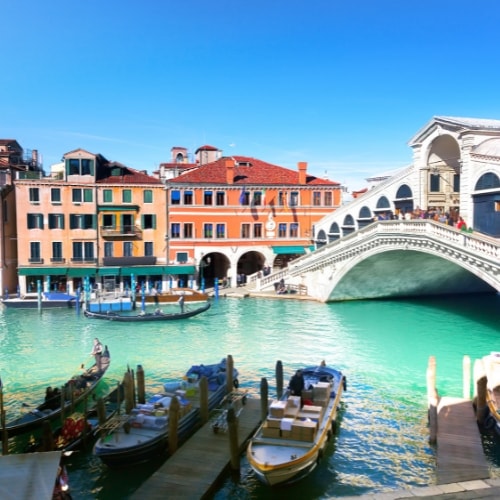
Venice Pass 2 Days
What to do in 2 days in Venice with Venice Pass?
💰 Incredible savings
🏛️ Top attractions and activities included
🚌 Unlimited travel by public transport (optional)
📲 Green choice all tickets in one app
🗓️ Flexibility to decide on the day
Information on the Venice Pass 2 Days
Venice Pass 2 Days: what can you do?
Here are some of the experiences awaiting you with Venice Pass 2 Days:
- Admire the majestic Doge’s Palace
- Visit the museums of St. Mark’s Square
- Discover the incredible Glass Museum
- Explore the elegant Lace Museum
- Immerse yourself in nature at the Natural History Museum
- Stroll among some of the most beautiful historic palaces of Venice
- Taste cicchetti in a traditional Venetian osteria
- Enjoy Shopping with Fashion Passport: 10% discount at Noventa di Piave Designer Outlet
- Travel for free on Venice public transport for 2 days (optional)
How does Venice Pass 2 Days work?
- After purchase, you have 6 months to activate your Venice Pass. Activation is simple and immediate directly from the app, available on Google Play Store and App Store. The Pass will be valid for 2 consecutive days from activation.
- Once activated, show the QR code in the My Pass section of the app to access all included or discounted activities.
Where can you find the complete list of included and partner activities?
Check the full list of included or discounted attractions directly in the Venice Pass app.
What does this pass include?
The Doge’s Palace is a symbolic landmark of the city and a must-see during your visit to Venice. It is part of the St. Mark’s Museums complex, together with the Correr Museum, the National Archaeological Museum, and the Monumental Halls of the Marciana National Library. Located in St. Mark’s Square, the Doge’s Palace will captivate you with its stunning Gothic-style façades. Inside, gilded ceilings and frescoed halls by artists such as Titian, Tintoretto, Veronese, and Tiepolo make your visit truly unforgettable.
The Doge’s Palace was the former residence of the Doge and the seat of Venice's government, encapsulating the most important moments in the history of the Venetian Republic from its beginnings to its fall. Crossing the famous Bridge of Sighs, you will also visit the underground prisons where the condemned served their often lifelong sentences.
An unmissable visit to truly understand the soul and history of Venice. The Doge’s Palace is open daily from 12 PM to 7 PM; last admission at 6 PM.
The Correr Museum is located in St Mark's Square and is part of the St Mark's Museum complex like the Doge's Palace, the National Archaeological Museum and the Monumental Rooms of the Biblioteca Nazionale Marciana. Not to be missed during your visit to Venice. The Correr Museum was created from the collections that the Venetian notable and collector Toedoro Correr left to the city of Venice. The building is located right in front of St Mark's Basilica (where the ancient church of San Giminiano previously stood) and was erected during the Napoleonic era (1806-1814). The neoclassical style, typical of that era, can also be found in the frescoes and decorations in the entire rooms of the museum. The museum boasts several collections tracing the history of Venice. Not to be missed is the collection of works by the famous artist Canova. The Correr Museum can be visited daily from 10.00 am to 6.00 pm (last admission at 5.00 pm).
<p>The National Archaeological Museum is located in St. Mark's Square and is part of the St. Mark's Museums complex along with the Doge's Palace, the Correr Museum, and the Monumental Rooms of the Marciana National Library. The National Archaeological Museum is one of the most famous and oldest public museums in Europe. The initial core of the collection, in fact, dates back to 1523 and 1587, following donations by members of the notable Venetian Grimani family (Domenico Grimani first and Giovanni Grimani later). Initially the collection was housed in the Antisala of the S. Mark’s Library. Following further donations between the 17th and 18th centuries, it was temporarily transferred to the Doge's Palace in 1812 and then moved to its current location on the second floor of the Procuratie Nuove. In the National Archaeological Museum of Venice you can admire various examples of ancient and classical art: Greek sculptures dating from the 5th-4th centuries B.C., portraits from the Roman period, reliefs, inscriptions, ceramics and gems. The National Archaeological Museum is open every day from 10.00 a.m. to 6.00 p.m. (last entry 5.00 p.m.). </p>
<p>The Monumental Rooms of the Marciana National Library stand in the heart of Venice, in St. Mark's Square. They are part of the Museums of St. Mark's Square complex, like the Doge's Palace, the Correr Museum and the National Archaeological Museum. The National Library building, in addition to the Library, houses the Fabbrica della Zecca, where the reading rooms are located. The National Library was designed and erected by Jacopo Sansovino, a Venetian architect and sculptor, between 1537 and 1560 at the behest of the procurators of St. Mark's. There was a need for a place to store the ancient Greek and Latin codices donated to the Republic of Venice in 1468 by Cardinal Bessarione. Later other codices and manuscripts flowed into the collection. Now they are still housed in the Biblioteca Nazionale Marciana, including the Grimani Breviary of the 500s, Fra Muro's Mappamondo, and Aldo Manuzio's ancient editions. The Monumental Rooms house portraits by Tintoretto and Veronese (21 tondi depicting faces of Philosophers) and frescoes by Tiziano (like the famous La Sapienza in the Vestibule, on the second floor). The Monumental Rooms of the Marciana National Library can be visited every day from 10.00 a.m. to 6.00 pm (last entry is 5.00 p.m). It is closed on 25th December and 1st January.</p>
Ca' Rezzonico is one of the most fascinating and iconic palaces in Venice. It is located in the Dorsoduro sestiere (neighborhood) overlooking the Grand Canal. It houses the Museo del Settecento Veneziano, which is part of the network of Venetian Civic Museums. In the museum, you can find a vast collection of paintings dating back to the 18th century and tracing the history and grandeur of the Serenissima. The museum is also worth a visit for the beauty of the palace itself; its history is long, troubled and fascinating. In fact, the palace was built starting in 1649 on the design of architect Baldassarre Longhena, a great master of Venetian Baroque, commissioned by the Bon family. In 1682 the architect's death and the financial problems of the commissioners led to the suspension of work. The Ca’ Rezzonico palace project thus remained unfinished for a long time. In 1751 the Lombard-born merchant and banker Giambattista Rezzonico purchased the property and entrusted its completion to Giorgio Massari, who completed the project in just 5 years. 50 years of feasting and splendor followed. Giambattista's younger brother, Carlo Rezzonico, bishop of Padua, was elected pope with the name Clement XIII in 1758, and Ca' Rezzonico was the site of lavish celebration for the new title. In 1810, however, the decline of the Rezzonico family began and along with it that of the palace. Ca’ Rezzonico was progressively and inexorably stripped and its riches were dispersed and dismembered, amid divisions of heirs and outright robberies. During the 19th century, the palace was sold to various buyers including the English painter Robert Barret Browning and then his father, the writer Robert Browning. Later the palace was bought by Count Lionello Hirschell de Minerbi who, after a long negotiation, gave it to the City of Venice in 1935. Ca’ Rezzonico is open from 10.00 a.m to 6.00 p.m. (the last entry is at 5 p.m.). It is closed on Tuesdays.
Palazzo Mocenigo is located in the sestiere (neighborhood) of Santa Croce and houses the Study Centre for the History of Textiles, Costume and Perfume. It is part of the network of Venetian Civic Museums. Visiting the palace and its museum will immerse you in the history of Venice and its wonderful textiles and costumes. The museum consists of 20 rooms in which you will be able to observe and touch the beauty of the costumes that made Venice famous throughout the world. The area dedicated to perfumes will lead you through sensory experiences and multimedia supports to delve into the intangible charm of fragrances. The museum is nestled in an unmissable setting: the Mocenigo Palace. It is a historic palace, whose first plan dates back to the 1500s. Later the palace was enlarged and modified by unknown architects. The appearance it retains today probably dates back to the 17th century. In 1945 the palace was donated to the City of Venice by the last heir of the Mocenigo family, Alvise Nicolò, to be used as an Art Gallery. Then between the 70s and 80s, the palace became part of the Civic Museums network and was permanently opened to the public. The palace can be visited from 10 a.m. to 6 p.m.; the last admission is at 5 p.m. The palace is closed on Mondays, on December 25th, January 1st, and May 1st.
The Carlo Goldoni House is located in the sestiere (neighborhood) of San Polo and is part of the network of Venetian Civic Museums. The entrance is on Calle dei Nomboli. The palace was erected in the 15th century and is an interesting example of Venetian Gothic, with its triptych facade, quadrifora and striking external staircase. The Goldoni family settled here in the late 1600s, when Carlo's grandfather, Carlo Alessandro, a notary of Modenese origin, chose this palace as his home. Here, on February 25, 1707, the great playwright saw the light. The Goldoni family lived in the palace until 1719. In 1914 a group of scholars and enthusiasts bought the palace from the last owner, Ida Manassero Camozzo, with the idea of creating a museum space to be dedicated to the illustrious playwright and the whole of Italian drama. Unfortunately, the great wars slowed down the project. In 1953 the Goldonian museum finally opened to the public. Today the Carlo Goldoni House houses Venetian theatrical memorabilia but is also a study center with its own library and an ever-evolving archive. You can visit Carlo Goldoni House from 10.00 a.m. to 4 p.m. (the last entry is at 3 p.m.). The Carlo Goldoni House is closed on Wednesdays, on December 25th, January 1st and May 1st.
If you love art you shouldn’t miss a visit to Ca’Pesaro. Ca’Pesaro is a stately historic palace in Venice located in the sestiere (neighborhood) of Santa Croce. Today, Ca’Pesaro houses the Gallery of Modern Art and Museum of Oriental Art and is part of the Venice Civic Museums network. It was Duchess Felicita Bevilacqua La Masa, the last owner of the palace and an art lover, who dedicated the historic building to Modern and Oriental Art and then donated it to the city. Ca’Pesaro preserves within itself a history already devoted to art. The palace was built on the Grand Canal by the Pesaro family in the second half of the 17th century. The Pesaro family enriched the palace with ornaments and frescoes, but also with a substantial art collection that included works by the likes of Tintoretto, Tiziano and Giorgione. Of this collection, however, only archival documents remain: most of it was sold at auction in 1830 by the last heir of the Pesaro family. Later the palace passed to the Gradenigo family and then to the Mechitarist Armenian Fathers, who used it as a boarding school. Ca'Pesaro- International Gallery of Modern Art and Museum of Oriental Art can be visited daily, except Mondays, from 10 a.m. to 6 p.m. (last admission at 5 p.m.).
Murano is known worldwide for its illustrious glassmaking. Your trip to Venice cannot continue without a stop in Murano to admire up close the technique and the most beautiful creations of the master glassmakers. The Murano Glass Museum is located in Palazzo Giustiniani and is part of the Venice Civic Museums network. You can easily reach Murano Glass Museum by public transportation provided by the city of Venice in about 19 min by ferry. Visiting the Glass Museum in Murano will be a unique experience that will allow you to discover the history of the ancient technique of glassmaking handed down from generation to generation on this small island in the lagoon. The museum houses chronologically ordered collections: from archaeological finds dating back to the Roman Empire between the 1st and 3rd centuries a.D., to historical pieces from the 1400s to the present. The museum was founded in 1861 with the clear goal of celebrating the history of Murano's glassmaking art by collecting all the evidence that can be found. The Murano Glass Museum can be visited daily from 10 a.m. to 6 p.m. (last admission at 5 p.m.).
Your visit to Venice cannot be completed without a visit to Burano and the Lace Museum. The Lace Museum has been part of the Venice Civic Museums network since 1995 and is well worth a visit to learn more about the ancient arts of Venetian lace-making. The Lace Museum is located in Piazza Galuppi; you can reach Burano in about 45 min by ferry from Venice. The Lace Museum houses more than 200 precious examples of lace from the 500s to the 900s. In addition to admiring pieces of great value, at the Lace Museum you can learn more precisely about the working technique handed down from generation to generation by the lace makers, who are still the secrets keepers of this precious art. The Museum also houses an archive of historical documents, photos and testimonies, which scholars and enthusiasts can consult for documentation and further study. The Lace Museum is open every day but on Mondays, on December 25th, January 1st, and May 1st from 10 a.m. to 4 p.m. (last admission at 4 p.m.).
<p>The Natural History Museum is located in the Fontego de Turchi, one of the oldest palaces overlooking the Grand Canal in Venice. The Museum of Natural History is part of the network of Civic Museums of Venice and is a true scientific institution. In addition to valuable collections, the museum houses a scientific library and a study center that monitors the flora and fauna of the lagoon. On the ground floor of the museum, in addition to the recently renovated reception rooms, you will find two of the museum's most important sections: the Cetacean Gallery and the Tegnuè Aquarium. On the second floor, you can also visit a charming garden. The second floor, then, houses three more sections: one dedicated to paleontology and fossils (On the Trails of Life); one dedicated to nature collecting (Collect to Amaze, Collect to Study); and one dedicated to the variety of species and living forms (The Strategies of Life). The Natural History Museum can be visited from 10 am to 6 p.m. (last admission at 5 p.m.). The museum is closed every Monday, on December 25th, January 1st, and May 1st. </p>
Fortuny Museum is located in St. Mark sestiere (district) and is part of the network of Venetian Civic Museums. The museum is located in a beautiful Gothic palace: palazzo Pesaro degli Orfei in Campo San Beneto, formerly owned by the Pesaro family. The museum owes its name to Mariano Fortuny y Madrazo (1871 - 1949), a Spanish-born painter, set designer, photographer, and fashion designer who established his atelier in Palazzo Pesaro. The Fortuny Museum is in fact a house museum that preserves the most significant works of the eclectic artist. The house museum consists of several spaces including the Winter Garden, a room with trompe-l'oeil frescoes made by Fortuny. The Fortuny Museum's collection is divided by themes that reflect the artist's areas of interest and action: painting, photography, light, textiles. The Fortuny Museum can be visited from 10 a.m. to 6 p.m.; the last admission is at 5 p.m. The museum is closed on Tuesdays, on December 25th, January 1st and May 1st. </p>
Discounted activities and the relative discounts offered to 'Venice Pass' holders can be consulted directly within the App on the Home page or by navigating to www.visitvenezia.eu. The discounts applied by the activities are visible with a percentage at the top right of the affiliated cards.
Additional options you can add to your pass
A symbol of Byzantine Venice, St. Mark’s Basilica is a cathedral that leaves visitors in awe with its golden mosaics, imposing domes, and the fusion of styles. Located in the square of the same name, the heart of the city, it has embodied the religious and political soul of the Serenissima for centuries. Originally built as the Doge’s private chapel, it later became a ceremonial center of the Republic, hosting coronations and religious celebrations tied to the city's political life. Today, it houses the relics of St. Mark, the patron saint of Venice, and continues to stand as an undisputed symbol of Venetian history. Inside, gold dominates the scene, with magnificent geometric floors and spectacular marble columns, evoking the image of a city that made beauty its universal language.
What's Included:
- Skip-the-line access to St. Mark’s Basilica
- Access to the ground floor of the Basilica
- Digital audio guide
What You'll See:
- The stunning golden mosaics that decorate over 8,000 m² of the basilica
- The interior of the central nave, with inlaid marble floors and Byzantine architecture
- The unique atmosphere of the basilica's ground floor, with columns, arches, and golden light effects
Important information:
- Address: St. Mark's Square, 328, 30100 Venice, (VE)
- Opening hours: Daily from 9:30 AM to 5:15 PM. Opening hours on Sundays and public holidays begin at 2:00 PM
- Wheelchair accessible
Don’t miss the guided tour of St. Mark’s Basilica, the symbol of Venice. Skip the line and enjoy a privileged and meaningful experience in one of the most spectacular and iconic cathedrals in the world. Located in the magnificent St. Mark’s Square, this basilica is a masterpiece of architecture and art. You will be accompanied by an expert and passionate guide who will reveal the secrets of Byzantine art and the rich history of this unique monument. Give yourself the opportunity to explore the basilica without long waits, benefiting from a detailed and insightful narration that will make this visit a memorable and culturally enriching experience during your next trip to Venice.
What’s included
- Guided tour
- Headphones to hear the guide
- Skip-the-line entrance
- Access to the ground floor
- “Venice in the Past” VR experience (before or after the guided tour, your choice)
What you will see
- The golden mosaics of the Basilica, covering 43,000 square meters
- The intricate marble inlays of the floors
- Biblical scenes and historical features of the basilica explained by the guide
Important Information
- Meeting point: St. Mark’s Square 328, St. Mark’s Basilica
- For access details, please refer to your voucher
- Duration: 50 minutes
- Guide Languages: English, French.
- Maximum group size: 20
- Mobile tickets accepted
Skip the line to this stunning Italian Opera House and check out the Maria Callas exhibition, which will walk you through the famed soprano's fascinating Venetian years. Explore the Foyer, Hall Theatre, Royal Box and Apollonian Halls with an audio guide for a real taste of operatic, theatrical Venice!
Opera is to Venice what pizza is to Naples, and the Teatro La Fenice will give you a delicious taste of all things theatrical and Italian. This stunning building is one of the most important landmarks in the history of Italian theater, and in the entire history of opera!
Dig deep into the theater's history, from its origins to the present day, and check out the Maria Callas exhibition. This talented Greek-American soprano was one of the most famous and influential opera singers of the 20th-century. Her Venetian years were some of her finest, and you're about to learn why.
Wander the halls, soak up the atmosphere, and if you're feeling brave, try and hit a high note!
Gondola Tour of Venice
Experience the authentic atmosphere of Venice with a captivating gondola ride through its charming canals. Depart from the heart of the city and let yourself be carried away by the elegance of this unique experience, while an expert gondolier guides you through picturesque views and historic palaces.
What’s included?
- Shared 30-minute gondola ride (maximum 15 passengers)
- Multilingual staff at the embarkation point
- Tour commentary via a digital audio guide in 9 languages
What’s not included?
- Tips (optional)
- Live guide
What will you see?
Sail through the Venetian canals and admire architectural wonders such as the Peggy Guggenheim Collection Palace, Palazzo Gritti, the majestic Basilica della Salute, Punta della Dogana, and many other hidden treasures. Take advantage of the space aboard to snap the perfect selfie and experience Venice like a true protagonist!
Important Information
- Meeting point: Campo San Gallo, San Marco 1093/B, Venice Tours office
- Show your booking confirmation at the assistance desk in Piazza San Marco
- Look for the representative with the "Gondola Tour" sign and the "Venice City Tour" logo on their shirt
- Arrive at least 10 minutes before the scheduled departure time
- The embarkation and disembarkation point is the same
- The itinerary may change in case of wind or bad weather
- Audio commentary is available in English, French, Spanish, Italian, German, Japanese, Chinese, Hindi, and Russian via a mobile app to download on your device
In a city without streets, the gondola is the symbol of Venice. Sit back and relax as the gondolier, with his classic striped shirt, guides you through the maze of canals to the Grand Canal.
Experience the timeless charm of the Serenissima and let passersby admire you as you glide along the waters for a truly affordable price.
Peggy Guggenheim Collection: Fast Track
With this ticket, you have fast-track access to one of the most important collections of contemporary art in Venice and in Italy.
The Peggy Guggenheim Collection includes works by the most revolutionary artists of the 20th century: Picasso, de Chirico, Dalí, Pollock, Kandinsky, and Magritte.
By visiting this museum you can get a close look at masterpieces from the most important artistic movements of the 20th century: cubism, surrealism, futurism, European abstractionism, and metaphysical painting.
Immerse yourself in works of enormous fascination and mystery in this iconic building overlooking the canal.
Peggy Guggenheim Collection stands on a site that was once the home of Guggenheim, an American art patron and collector who loved Venice deeply. It is the Palazzo Venier dei Leoni, on the Grand Canal.
All the works in the collection were part of Peggy's private collection. Learn more about the history by walking through this a fascinating historic palace, which you can admire in all its beauty already from the canal.
How to get there:
- From Piazzale Roma or railway station: vaporetto 1 or 2, direction Lido, get off at Accademia stop
- From St. Mark's Square: vaporetto 1 or 2, direction Piazzale Roma, get off at the Accademia stop
Traveling by public transport in Venice can be complicated and expensive, as you need to purchase different tickets for each route and validate them in the appropriate machines, but ticket offices are not always open. We recommend adding the "unlimited transport" option to your Venice Pass to have everything in one app and make your visit to Venice more convenient and enjoyable.
Venice Pass gives you the access to Public Transport with ACTV, a ticket (to be collected by entering the personal PNR booking code of VeneziaUnica, present on the My Venice Pass screen, at one of the ACTV ticket machines or by presenting your voucher with one of the many Points of sale and collection in the city) with which it will be possible make use of transport throughout the city of Venice.
IMPORTANT: To activate your ticket, you must validate your card (at turnstiles or directly on board buses) the first time you access public transportation. The green light and an audible signal indicate that the ticket has been validated correctly. The ticket is also used to open the barriers on the piers.